Audit Risk Assignment: Exam, BAF-7-AUR, May 2020, LSBU
VerifiedAdded on 2022/12/30
|9
|2621
|86
Homework Assignment
AI Summary
This document provides a comprehensive solution to an audit risk assignment, addressing various aspects of auditing. It begins by defining subsequent events and their implications, including adjusting and non-adjusting events, and the auditor's responsibilities in considering them. The assignment then delves into the recognition of provisions, contingent assets, and liabilities according to IAS 37, with practical examples. It further explores auditor independence, ethical considerations, and potential conflicts of interest, providing scenarios and solutions. The document also discusses the importance of sufficient and appropriate audit evidence, outlining procedures for verifying loans, investments, and fixed assets. Internal controls, their deficiencies, and their impact on the auditor's opinion are examined, along with the auditor's role in verifying asset ownership, disposal, and depreciation. Finally, the assignment addresses the use of outdated software in recording receivables and the implications of auditing around a computer system, offering practical insights and solutions for each scenario. This assignment is contributed by a student to be published on the website Desklib. Desklib is a platform which provides all the necessary AI based study tools for students.
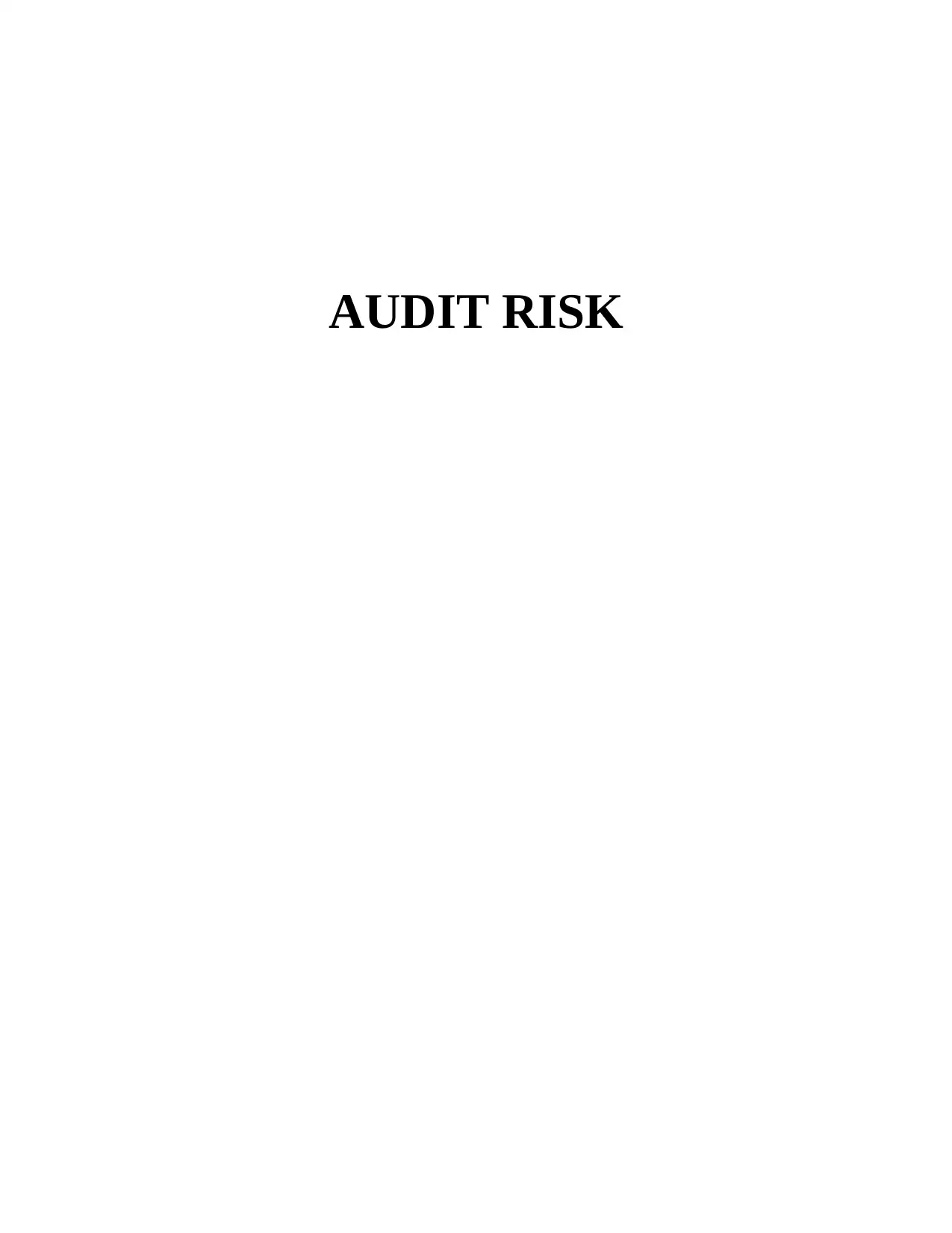
AUDIT RISK
Paraphrase This Document
Need a fresh take? Get an instant paraphrase of this document with our AI Paraphraser
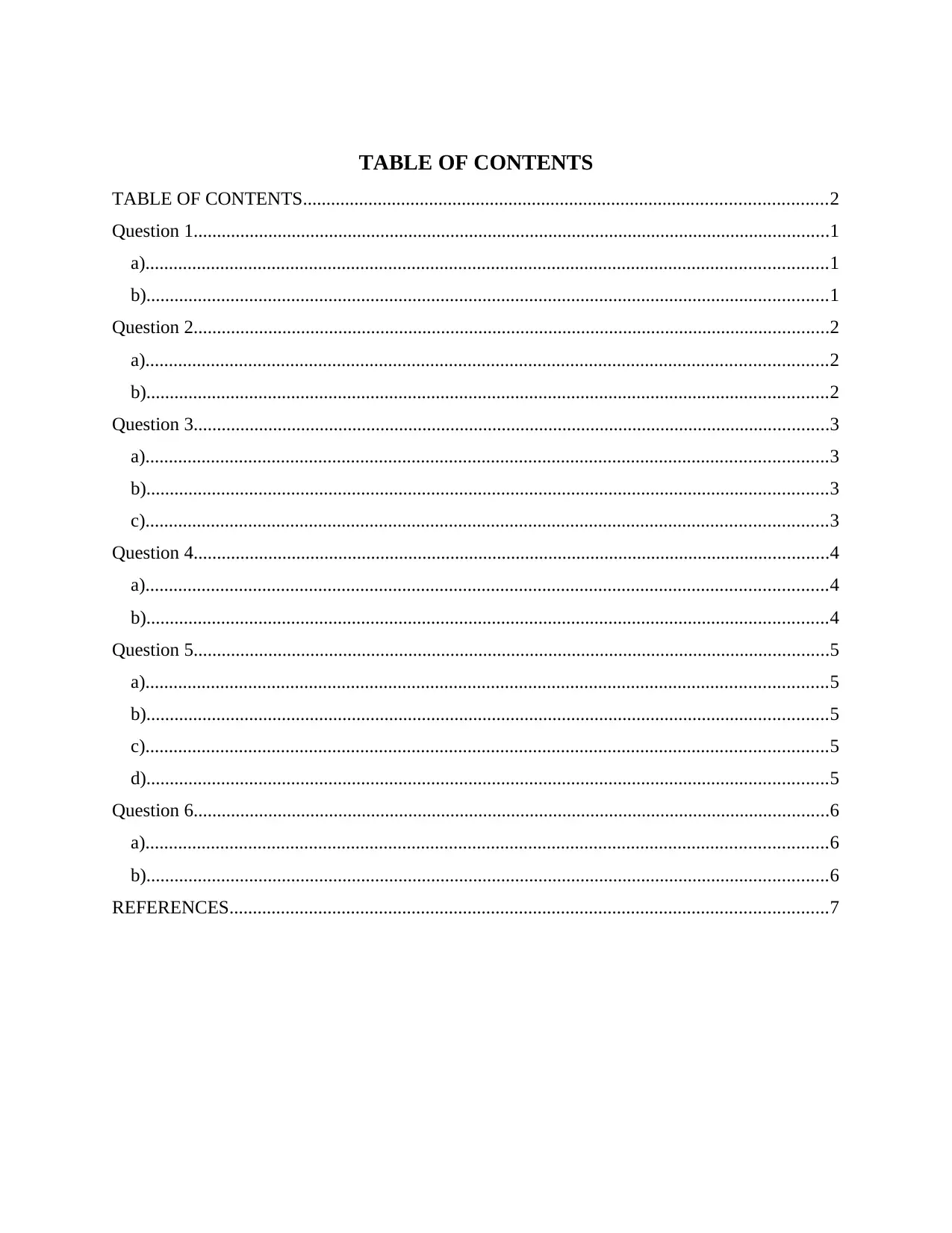
TABLE OF CONTENTS
TABLE OF CONTENTS................................................................................................................2
Question 1........................................................................................................................................1
a)..................................................................................................................................................1
b)..................................................................................................................................................1
Question 2........................................................................................................................................2
a)..................................................................................................................................................2
b)..................................................................................................................................................2
Question 3........................................................................................................................................3
a)..................................................................................................................................................3
b)..................................................................................................................................................3
c)..................................................................................................................................................3
Question 4........................................................................................................................................4
a)..................................................................................................................................................4
b)..................................................................................................................................................4
Question 5........................................................................................................................................5
a)..................................................................................................................................................5
b)..................................................................................................................................................5
c)..................................................................................................................................................5
d)..................................................................................................................................................5
Question 6........................................................................................................................................6
a)..................................................................................................................................................6
b)..................................................................................................................................................6
REFERENCES................................................................................................................................7
TABLE OF CONTENTS................................................................................................................2
Question 1........................................................................................................................................1
a)..................................................................................................................................................1
b)..................................................................................................................................................1
Question 2........................................................................................................................................2
a)..................................................................................................................................................2
b)..................................................................................................................................................2
Question 3........................................................................................................................................3
a)..................................................................................................................................................3
b)..................................................................................................................................................3
c)..................................................................................................................................................3
Question 4........................................................................................................................................4
a)..................................................................................................................................................4
b)..................................................................................................................................................4
Question 5........................................................................................................................................5
a)..................................................................................................................................................5
b)..................................................................................................................................................5
c)..................................................................................................................................................5
d)..................................................................................................................................................5
Question 6........................................................................................................................................6
a)..................................................................................................................................................6
b)..................................................................................................................................................6
REFERENCES................................................................................................................................7
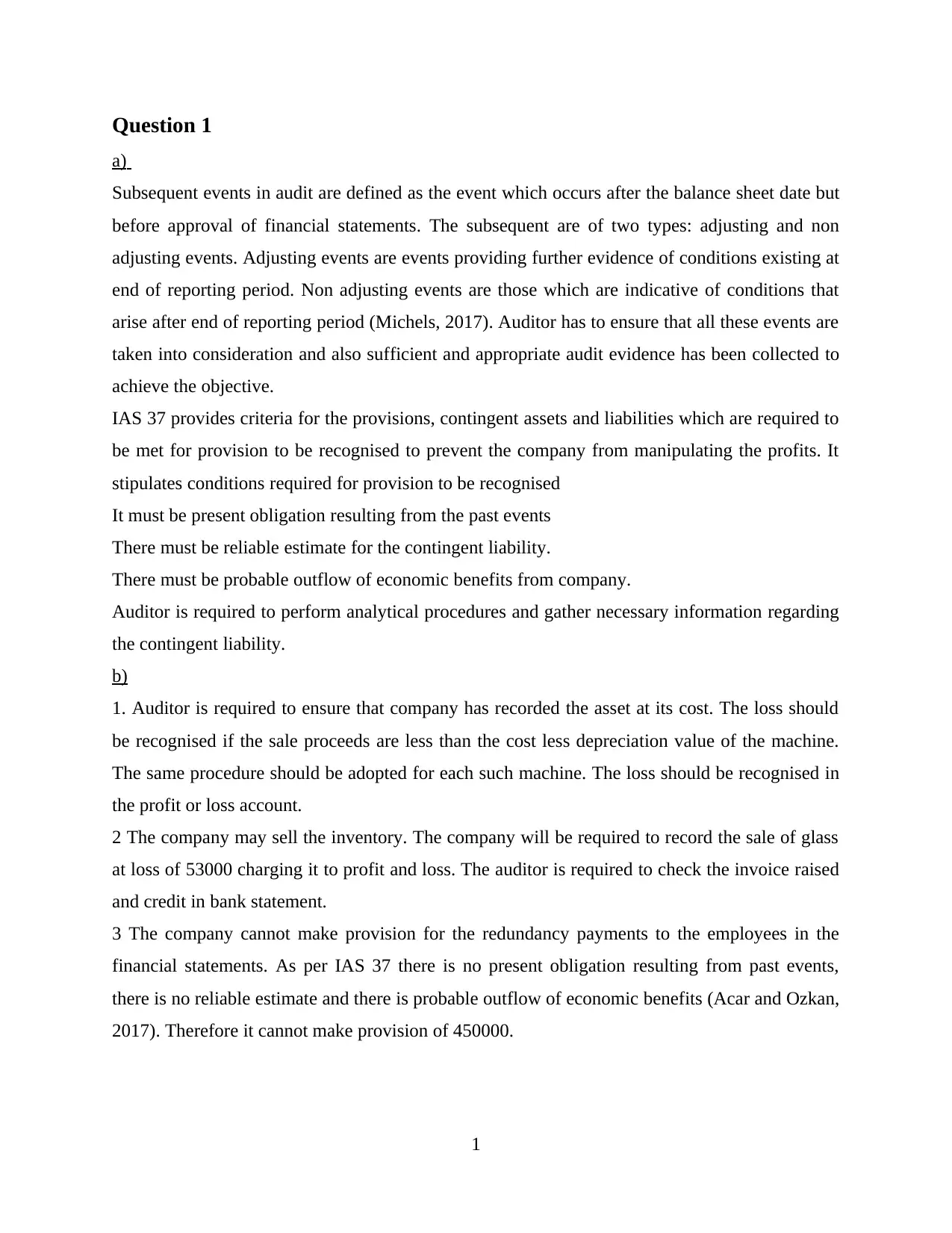
Question 1
a)
Subsequent events in audit are defined as the event which occurs after the balance sheet date but
before approval of financial statements. The subsequent are of two types: adjusting and non
adjusting events. Adjusting events are events providing further evidence of conditions existing at
end of reporting period. Non adjusting events are those which are indicative of conditions that
arise after end of reporting period (Michels, 2017). Auditor has to ensure that all these events are
taken into consideration and also sufficient and appropriate audit evidence has been collected to
achieve the objective.
IAS 37 provides criteria for the provisions, contingent assets and liabilities which are required to
be met for provision to be recognised to prevent the company from manipulating the profits. It
stipulates conditions required for provision to be recognised
It must be present obligation resulting from the past events
There must be reliable estimate for the contingent liability.
There must be probable outflow of economic benefits from company.
Auditor is required to perform analytical procedures and gather necessary information regarding
the contingent liability.
b)
1. Auditor is required to ensure that company has recorded the asset at its cost. The loss should
be recognised if the sale proceeds are less than the cost less depreciation value of the machine.
The same procedure should be adopted for each such machine. The loss should be recognised in
the profit or loss account.
2 The company may sell the inventory. The company will be required to record the sale of glass
at loss of 53000 charging it to profit and loss. The auditor is required to check the invoice raised
and credit in bank statement.
3 The company cannot make provision for the redundancy payments to the employees in the
financial statements. As per IAS 37 there is no present obligation resulting from past events,
there is no reliable estimate and there is probable outflow of economic benefits (Acar and Ozkan,
2017). Therefore it cannot make provision of 450000.
1
a)
Subsequent events in audit are defined as the event which occurs after the balance sheet date but
before approval of financial statements. The subsequent are of two types: adjusting and non
adjusting events. Adjusting events are events providing further evidence of conditions existing at
end of reporting period. Non adjusting events are those which are indicative of conditions that
arise after end of reporting period (Michels, 2017). Auditor has to ensure that all these events are
taken into consideration and also sufficient and appropriate audit evidence has been collected to
achieve the objective.
IAS 37 provides criteria for the provisions, contingent assets and liabilities which are required to
be met for provision to be recognised to prevent the company from manipulating the profits. It
stipulates conditions required for provision to be recognised
It must be present obligation resulting from the past events
There must be reliable estimate for the contingent liability.
There must be probable outflow of economic benefits from company.
Auditor is required to perform analytical procedures and gather necessary information regarding
the contingent liability.
b)
1. Auditor is required to ensure that company has recorded the asset at its cost. The loss should
be recognised if the sale proceeds are less than the cost less depreciation value of the machine.
The same procedure should be adopted for each such machine. The loss should be recognised in
the profit or loss account.
2 The company may sell the inventory. The company will be required to record the sale of glass
at loss of 53000 charging it to profit and loss. The auditor is required to check the invoice raised
and credit in bank statement.
3 The company cannot make provision for the redundancy payments to the employees in the
financial statements. As per IAS 37 there is no present obligation resulting from past events,
there is no reliable estimate and there is probable outflow of economic benefits (Acar and Ozkan,
2017). Therefore it cannot make provision of 450000.
1
⊘ This is a preview!⊘
Do you want full access?
Subscribe today to unlock all pages.

Trusted by 1+ million students worldwide
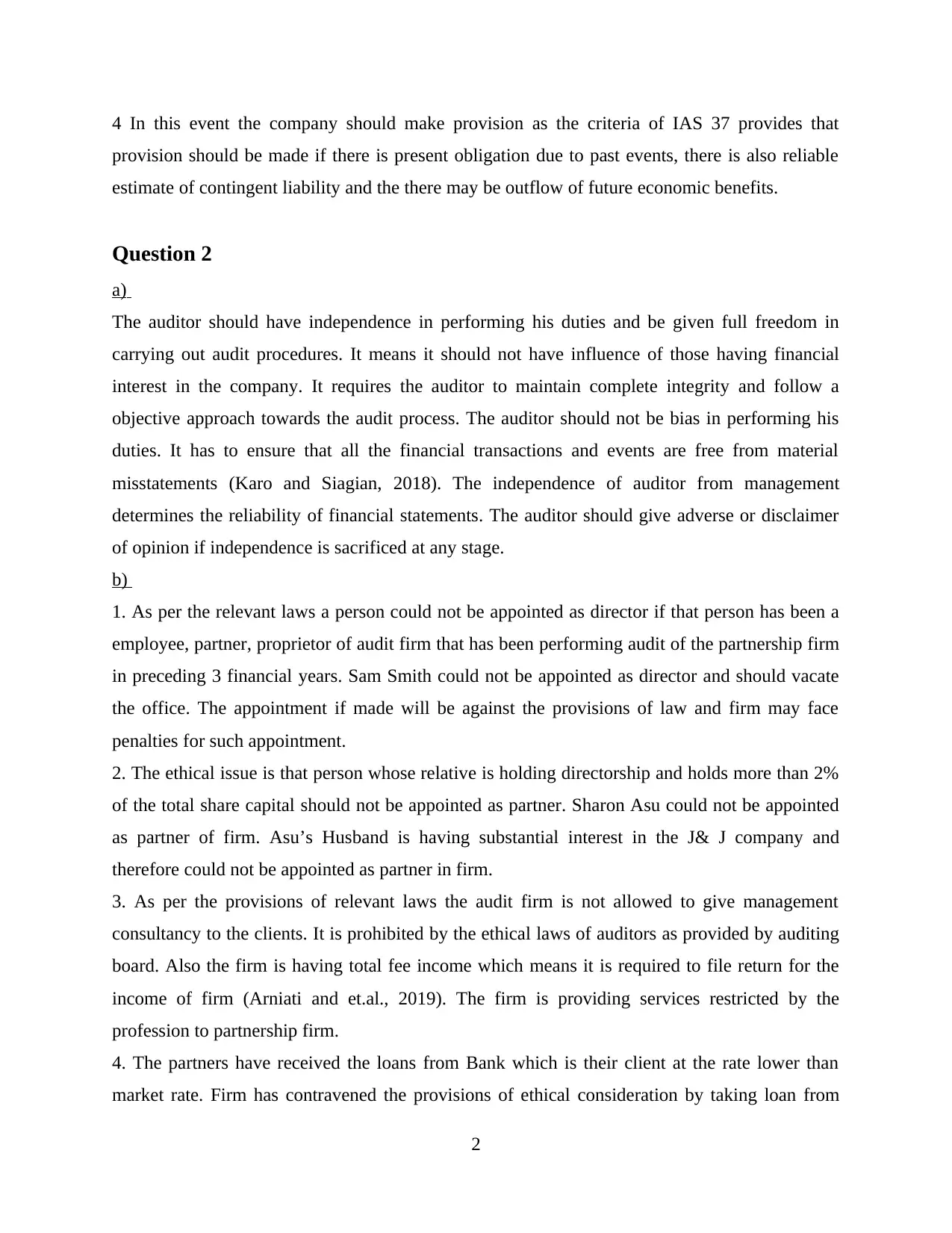
4 In this event the company should make provision as the criteria of IAS 37 provides that
provision should be made if there is present obligation due to past events, there is also reliable
estimate of contingent liability and the there may be outflow of future economic benefits.
Question 2
a)
The auditor should have independence in performing his duties and be given full freedom in
carrying out audit procedures. It means it should not have influence of those having financial
interest in the company. It requires the auditor to maintain complete integrity and follow a
objective approach towards the audit process. The auditor should not be bias in performing his
duties. It has to ensure that all the financial transactions and events are free from material
misstatements (Karo and Siagian, 2018). The independence of auditor from management
determines the reliability of financial statements. The auditor should give adverse or disclaimer
of opinion if independence is sacrificed at any stage.
b)
1. As per the relevant laws a person could not be appointed as director if that person has been a
employee, partner, proprietor of audit firm that has been performing audit of the partnership firm
in preceding 3 financial years. Sam Smith could not be appointed as director and should vacate
the office. The appointment if made will be against the provisions of law and firm may face
penalties for such appointment.
2. The ethical issue is that person whose relative is holding directorship and holds more than 2%
of the total share capital should not be appointed as partner. Sharon Asu could not be appointed
as partner of firm. Asu’s Husband is having substantial interest in the J& J company and
therefore could not be appointed as partner in firm.
3. As per the provisions of relevant laws the audit firm is not allowed to give management
consultancy to the clients. It is prohibited by the ethical laws of auditors as provided by auditing
board. Also the firm is having total fee income which means it is required to file return for the
income of firm (Arniati and et.al., 2019). The firm is providing services restricted by the
profession to partnership firm.
4. The partners have received the loans from Bank which is their client at the rate lower than
market rate. Firm has contravened the provisions of ethical consideration by taking loan from
2
provision should be made if there is present obligation due to past events, there is also reliable
estimate of contingent liability and the there may be outflow of future economic benefits.
Question 2
a)
The auditor should have independence in performing his duties and be given full freedom in
carrying out audit procedures. It means it should not have influence of those having financial
interest in the company. It requires the auditor to maintain complete integrity and follow a
objective approach towards the audit process. The auditor should not be bias in performing his
duties. It has to ensure that all the financial transactions and events are free from material
misstatements (Karo and Siagian, 2018). The independence of auditor from management
determines the reliability of financial statements. The auditor should give adverse or disclaimer
of opinion if independence is sacrificed at any stage.
b)
1. As per the relevant laws a person could not be appointed as director if that person has been a
employee, partner, proprietor of audit firm that has been performing audit of the partnership firm
in preceding 3 financial years. Sam Smith could not be appointed as director and should vacate
the office. The appointment if made will be against the provisions of law and firm may face
penalties for such appointment.
2. The ethical issue is that person whose relative is holding directorship and holds more than 2%
of the total share capital should not be appointed as partner. Sharon Asu could not be appointed
as partner of firm. Asu’s Husband is having substantial interest in the J& J company and
therefore could not be appointed as partner in firm.
3. As per the provisions of relevant laws the audit firm is not allowed to give management
consultancy to the clients. It is prohibited by the ethical laws of auditors as provided by auditing
board. Also the firm is having total fee income which means it is required to file return for the
income of firm (Arniati and et.al., 2019). The firm is providing services restricted by the
profession to partnership firm.
4. The partners have received the loans from Bank which is their client at the rate lower than
market rate. Firm has contravened the provisions of ethical consideration by taking loan from
2
Paraphrase This Document
Need a fresh take? Get an instant paraphrase of this document with our AI Paraphraser
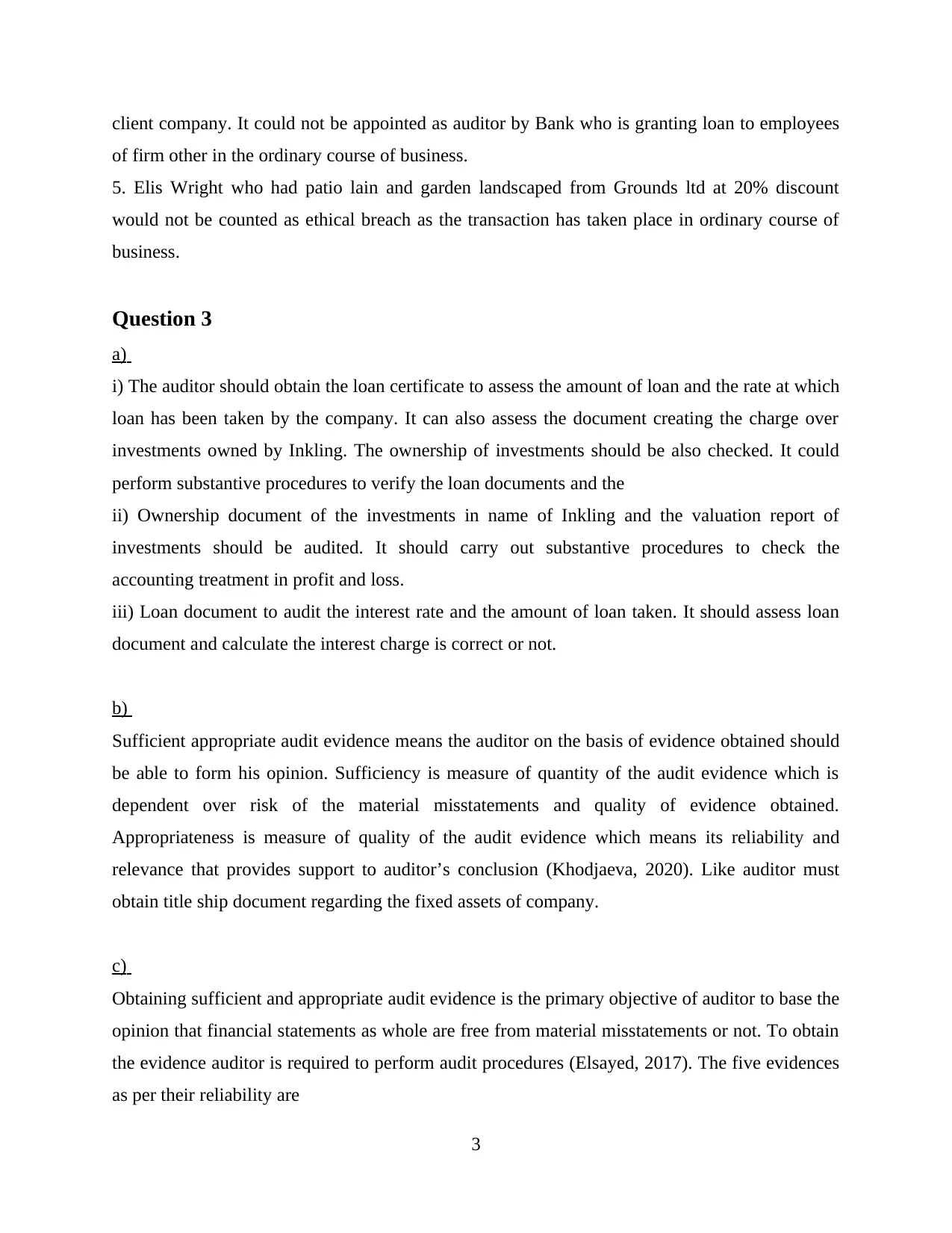
client company. It could not be appointed as auditor by Bank who is granting loan to employees
of firm other in the ordinary course of business.
5. Elis Wright who had patio lain and garden landscaped from Grounds ltd at 20% discount
would not be counted as ethical breach as the transaction has taken place in ordinary course of
business.
Question 3
a)
i) The auditor should obtain the loan certificate to assess the amount of loan and the rate at which
loan has been taken by the company. It can also assess the document creating the charge over
investments owned by Inkling. The ownership of investments should be also checked. It could
perform substantive procedures to verify the loan documents and the
ii) Ownership document of the investments in name of Inkling and the valuation report of
investments should be audited. It should carry out substantive procedures to check the
accounting treatment in profit and loss.
iii) Loan document to audit the interest rate and the amount of loan taken. It should assess loan
document and calculate the interest charge is correct or not.
b)
Sufficient appropriate audit evidence means the auditor on the basis of evidence obtained should
be able to form his opinion. Sufficiency is measure of quantity of the audit evidence which is
dependent over risk of the material misstatements and quality of evidence obtained.
Appropriateness is measure of quality of the audit evidence which means its reliability and
relevance that provides support to auditor’s conclusion (Khodjaeva, 2020). Like auditor must
obtain title ship document regarding the fixed assets of company.
c)
Obtaining sufficient and appropriate audit evidence is the primary objective of auditor to base the
opinion that financial statements as whole are free from material misstatements or not. To obtain
the evidence auditor is required to perform audit procedures (Elsayed, 2017). The five evidences
as per their reliability are
3
of firm other in the ordinary course of business.
5. Elis Wright who had patio lain and garden landscaped from Grounds ltd at 20% discount
would not be counted as ethical breach as the transaction has taken place in ordinary course of
business.
Question 3
a)
i) The auditor should obtain the loan certificate to assess the amount of loan and the rate at which
loan has been taken by the company. It can also assess the document creating the charge over
investments owned by Inkling. The ownership of investments should be also checked. It could
perform substantive procedures to verify the loan documents and the
ii) Ownership document of the investments in name of Inkling and the valuation report of
investments should be audited. It should carry out substantive procedures to check the
accounting treatment in profit and loss.
iii) Loan document to audit the interest rate and the amount of loan taken. It should assess loan
document and calculate the interest charge is correct or not.
b)
Sufficient appropriate audit evidence means the auditor on the basis of evidence obtained should
be able to form his opinion. Sufficiency is measure of quantity of the audit evidence which is
dependent over risk of the material misstatements and quality of evidence obtained.
Appropriateness is measure of quality of the audit evidence which means its reliability and
relevance that provides support to auditor’s conclusion (Khodjaeva, 2020). Like auditor must
obtain title ship document regarding the fixed assets of company.
c)
Obtaining sufficient and appropriate audit evidence is the primary objective of auditor to base the
opinion that financial statements as whole are free from material misstatements or not. To obtain
the evidence auditor is required to perform audit procedures (Elsayed, 2017). The five evidences
as per their reliability are
3
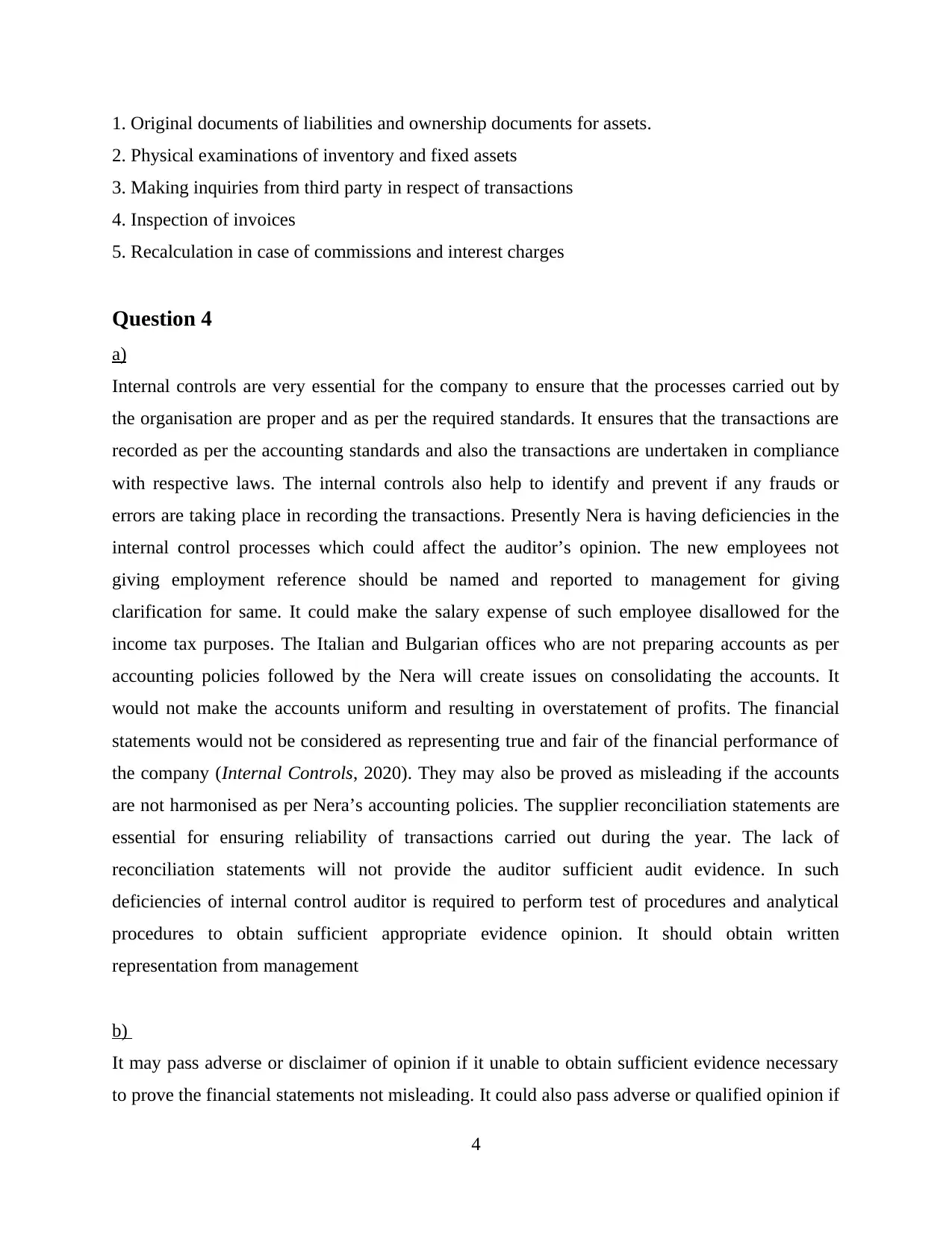
1. Original documents of liabilities and ownership documents for assets.
2. Physical examinations of inventory and fixed assets
3. Making inquiries from third party in respect of transactions
4. Inspection of invoices
5. Recalculation in case of commissions and interest charges
Question 4
a)
Internal controls are very essential for the company to ensure that the processes carried out by
the organisation are proper and as per the required standards. It ensures that the transactions are
recorded as per the accounting standards and also the transactions are undertaken in compliance
with respective laws. The internal controls also help to identify and prevent if any frauds or
errors are taking place in recording the transactions. Presently Nera is having deficiencies in the
internal control processes which could affect the auditor’s opinion. The new employees not
giving employment reference should be named and reported to management for giving
clarification for same. It could make the salary expense of such employee disallowed for the
income tax purposes. The Italian and Bulgarian offices who are not preparing accounts as per
accounting policies followed by the Nera will create issues on consolidating the accounts. It
would not make the accounts uniform and resulting in overstatement of profits. The financial
statements would not be considered as representing true and fair of the financial performance of
the company (Internal Controls, 2020). They may also be proved as misleading if the accounts
are not harmonised as per Nera’s accounting policies. The supplier reconciliation statements are
essential for ensuring reliability of transactions carried out during the year. The lack of
reconciliation statements will not provide the auditor sufficient audit evidence. In such
deficiencies of internal control auditor is required to perform test of procedures and analytical
procedures to obtain sufficient appropriate evidence opinion. It should obtain written
representation from management
b)
It may pass adverse or disclaimer of opinion if it unable to obtain sufficient evidence necessary
to prove the financial statements not misleading. It could also pass adverse or qualified opinion if
4
2. Physical examinations of inventory and fixed assets
3. Making inquiries from third party in respect of transactions
4. Inspection of invoices
5. Recalculation in case of commissions and interest charges
Question 4
a)
Internal controls are very essential for the company to ensure that the processes carried out by
the organisation are proper and as per the required standards. It ensures that the transactions are
recorded as per the accounting standards and also the transactions are undertaken in compliance
with respective laws. The internal controls also help to identify and prevent if any frauds or
errors are taking place in recording the transactions. Presently Nera is having deficiencies in the
internal control processes which could affect the auditor’s opinion. The new employees not
giving employment reference should be named and reported to management for giving
clarification for same. It could make the salary expense of such employee disallowed for the
income tax purposes. The Italian and Bulgarian offices who are not preparing accounts as per
accounting policies followed by the Nera will create issues on consolidating the accounts. It
would not make the accounts uniform and resulting in overstatement of profits. The financial
statements would not be considered as representing true and fair of the financial performance of
the company (Internal Controls, 2020). They may also be proved as misleading if the accounts
are not harmonised as per Nera’s accounting policies. The supplier reconciliation statements are
essential for ensuring reliability of transactions carried out during the year. The lack of
reconciliation statements will not provide the auditor sufficient audit evidence. In such
deficiencies of internal control auditor is required to perform test of procedures and analytical
procedures to obtain sufficient appropriate evidence opinion. It should obtain written
representation from management
b)
It may pass adverse or disclaimer of opinion if it unable to obtain sufficient evidence necessary
to prove the financial statements not misleading. It could also pass adverse or qualified opinion if
4
⊘ This is a preview!⊘
Do you want full access?
Subscribe today to unlock all pages.

Trusted by 1+ million students worldwide
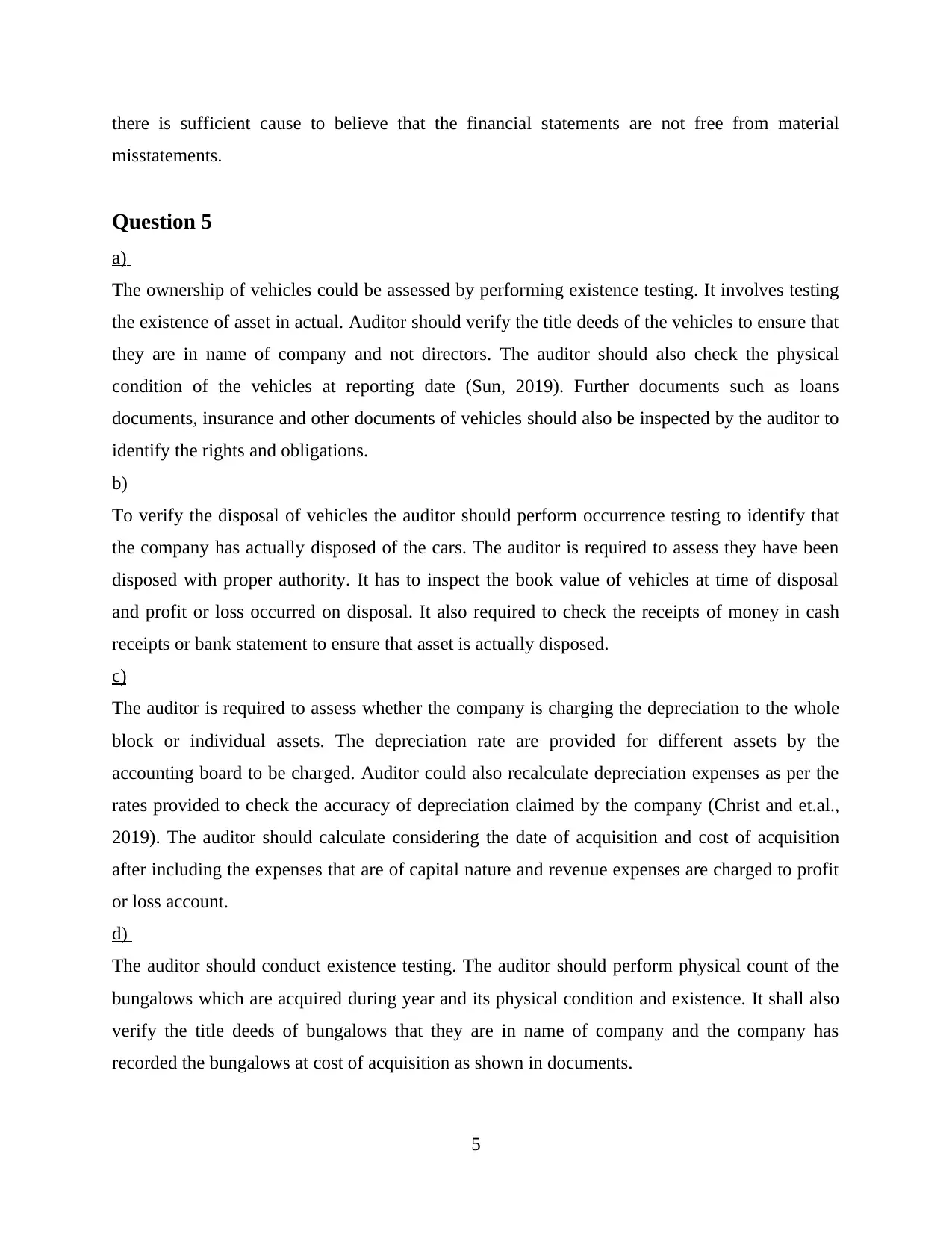
there is sufficient cause to believe that the financial statements are not free from material
misstatements.
Question 5
a)
The ownership of vehicles could be assessed by performing existence testing. It involves testing
the existence of asset in actual. Auditor should verify the title deeds of the vehicles to ensure that
they are in name of company and not directors. The auditor should also check the physical
condition of the vehicles at reporting date (Sun, 2019). Further documents such as loans
documents, insurance and other documents of vehicles should also be inspected by the auditor to
identify the rights and obligations.
b)
To verify the disposal of vehicles the auditor should perform occurrence testing to identify that
the company has actually disposed of the cars. The auditor is required to assess they have been
disposed with proper authority. It has to inspect the book value of vehicles at time of disposal
and profit or loss occurred on disposal. It also required to check the receipts of money in cash
receipts or bank statement to ensure that asset is actually disposed.
c)
The auditor is required to assess whether the company is charging the depreciation to the whole
block or individual assets. The depreciation rate are provided for different assets by the
accounting board to be charged. Auditor could also recalculate depreciation expenses as per the
rates provided to check the accuracy of depreciation claimed by the company (Christ and et.al.,
2019). The auditor should calculate considering the date of acquisition and cost of acquisition
after including the expenses that are of capital nature and revenue expenses are charged to profit
or loss account.
d)
The auditor should conduct existence testing. The auditor should perform physical count of the
bungalows which are acquired during year and its physical condition and existence. It shall also
verify the title deeds of bungalows that they are in name of company and the company has
recorded the bungalows at cost of acquisition as shown in documents.
5
misstatements.
Question 5
a)
The ownership of vehicles could be assessed by performing existence testing. It involves testing
the existence of asset in actual. Auditor should verify the title deeds of the vehicles to ensure that
they are in name of company and not directors. The auditor should also check the physical
condition of the vehicles at reporting date (Sun, 2019). Further documents such as loans
documents, insurance and other documents of vehicles should also be inspected by the auditor to
identify the rights and obligations.
b)
To verify the disposal of vehicles the auditor should perform occurrence testing to identify that
the company has actually disposed of the cars. The auditor is required to assess they have been
disposed with proper authority. It has to inspect the book value of vehicles at time of disposal
and profit or loss occurred on disposal. It also required to check the receipts of money in cash
receipts or bank statement to ensure that asset is actually disposed.
c)
The auditor is required to assess whether the company is charging the depreciation to the whole
block or individual assets. The depreciation rate are provided for different assets by the
accounting board to be charged. Auditor could also recalculate depreciation expenses as per the
rates provided to check the accuracy of depreciation claimed by the company (Christ and et.al.,
2019). The auditor should calculate considering the date of acquisition and cost of acquisition
after including the expenses that are of capital nature and revenue expenses are charged to profit
or loss account.
d)
The auditor should conduct existence testing. The auditor should perform physical count of the
bungalows which are acquired during year and its physical condition and existence. It shall also
verify the title deeds of bungalows that they are in name of company and the company has
recorded the bungalows at cost of acquisition as shown in documents.
5
Paraphrase This Document
Need a fresh take? Get an instant paraphrase of this document with our AI Paraphraser
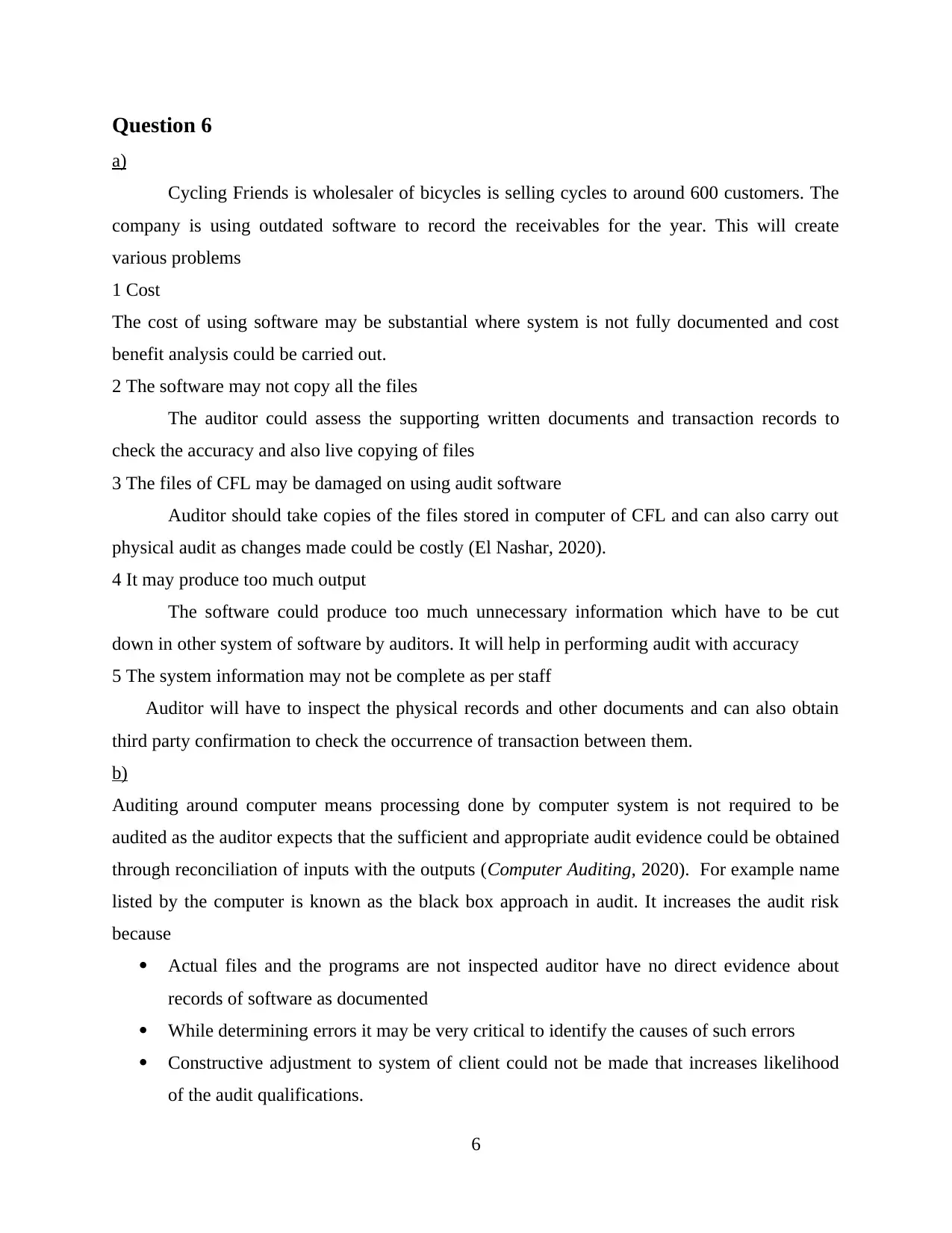
Question 6
a)
Cycling Friends is wholesaler of bicycles is selling cycles to around 600 customers. The
company is using outdated software to record the receivables for the year. This will create
various problems
1 Cost
The cost of using software may be substantial where system is not fully documented and cost
benefit analysis could be carried out.
2 The software may not copy all the files
The auditor could assess the supporting written documents and transaction records to
check the accuracy and also live copying of files
3 The files of CFL may be damaged on using audit software
Auditor should take copies of the files stored in computer of CFL and can also carry out
physical audit as changes made could be costly (El Nashar, 2020).
4 It may produce too much output
The software could produce too much unnecessary information which have to be cut
down in other system of software by auditors. It will help in performing audit with accuracy
5 The system information may not be complete as per staff
Auditor will have to inspect the physical records and other documents and can also obtain
third party confirmation to check the occurrence of transaction between them.
b)
Auditing around computer means processing done by computer system is not required to be
audited as the auditor expects that the sufficient and appropriate audit evidence could be obtained
through reconciliation of inputs with the outputs (Computer Auditing, 2020). For example name
listed by the computer is known as the black box approach in audit. It increases the audit risk
because
Actual files and the programs are not inspected auditor have no direct evidence about
records of software as documented
While determining errors it may be very critical to identify the causes of such errors
Constructive adjustment to system of client could not be made that increases likelihood
of the audit qualifications.
6
a)
Cycling Friends is wholesaler of bicycles is selling cycles to around 600 customers. The
company is using outdated software to record the receivables for the year. This will create
various problems
1 Cost
The cost of using software may be substantial where system is not fully documented and cost
benefit analysis could be carried out.
2 The software may not copy all the files
The auditor could assess the supporting written documents and transaction records to
check the accuracy and also live copying of files
3 The files of CFL may be damaged on using audit software
Auditor should take copies of the files stored in computer of CFL and can also carry out
physical audit as changes made could be costly (El Nashar, 2020).
4 It may produce too much output
The software could produce too much unnecessary information which have to be cut
down in other system of software by auditors. It will help in performing audit with accuracy
5 The system information may not be complete as per staff
Auditor will have to inspect the physical records and other documents and can also obtain
third party confirmation to check the occurrence of transaction between them.
b)
Auditing around computer means processing done by computer system is not required to be
audited as the auditor expects that the sufficient and appropriate audit evidence could be obtained
through reconciliation of inputs with the outputs (Computer Auditing, 2020). For example name
listed by the computer is known as the black box approach in audit. It increases the audit risk
because
Actual files and the programs are not inspected auditor have no direct evidence about
records of software as documented
While determining errors it may be very critical to identify the causes of such errors
Constructive adjustment to system of client could not be made that increases likelihood
of the audit qualifications.
6
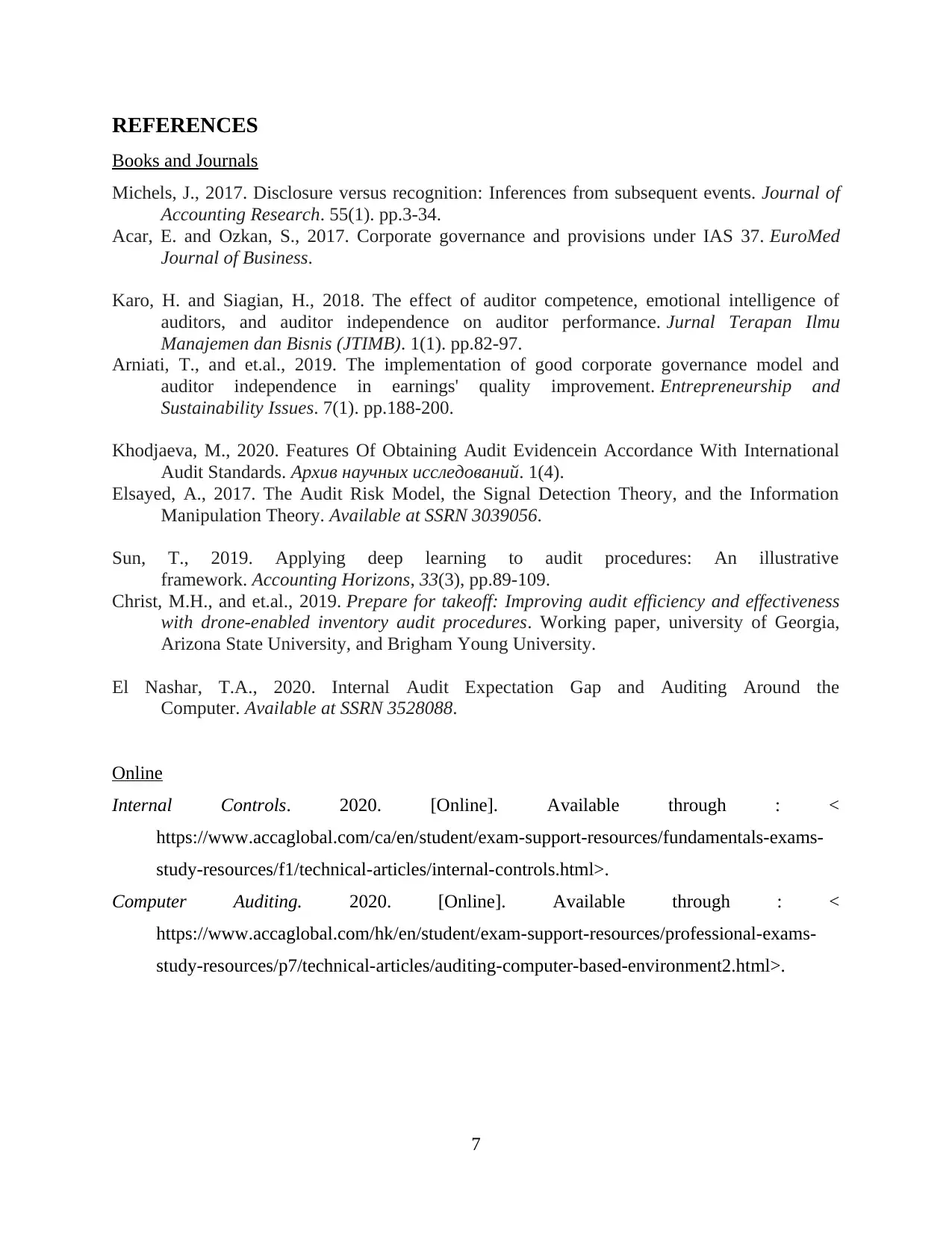
REFERENCES
Books and Journals
Michels, J., 2017. Disclosure versus recognition: Inferences from subsequent events. Journal of
Accounting Research. 55(1). pp.3-34.
Acar, E. and Ozkan, S., 2017. Corporate governance and provisions under IAS 37. EuroMed
Journal of Business.
Karo, H. and Siagian, H., 2018. The effect of auditor competence, emotional intelligence of
auditors, and auditor independence on auditor performance. Jurnal Terapan Ilmu
Manajemen dan Bisnis (JTIMB). 1(1). pp.82-97.
Arniati, T., and et.al., 2019. The implementation of good corporate governance model and
auditor independence in earnings' quality improvement. Entrepreneurship and
Sustainability Issues. 7(1). pp.188-200.
Khodjaeva, M., 2020. Features Of Obtaining Audit Evidencein Accordance With International
Audit Standards. Архив научных исследований. 1(4).
Elsayed, A., 2017. The Audit Risk Model, the Signal Detection Theory, and the Information
Manipulation Theory. Available at SSRN 3039056.
Sun, T., 2019. Applying deep learning to audit procedures: An illustrative
framework. Accounting Horizons, 33(3), pp.89-109.
Christ, M.H., and et.al., 2019. Prepare for takeoff: Improving audit efficiency and effectiveness
with drone-enabled inventory audit procedures. Working paper, university of Georgia,
Arizona State University, and Brigham Young University.
El Nashar, T.A., 2020. Internal Audit Expectation Gap and Auditing Around the
Computer. Available at SSRN 3528088.
Online
Internal Controls. 2020. [Online]. Available through : <
https://www.accaglobal.com/ca/en/student/exam-support-resources/fundamentals-exams-
study-resources/f1/technical-articles/internal-controls.html>.
Computer Auditing. 2020. [Online]. Available through : <
https://www.accaglobal.com/hk/en/student/exam-support-resources/professional-exams-
study-resources/p7/technical-articles/auditing-computer-based-environment2.html>.
7
Books and Journals
Michels, J., 2017. Disclosure versus recognition: Inferences from subsequent events. Journal of
Accounting Research. 55(1). pp.3-34.
Acar, E. and Ozkan, S., 2017. Corporate governance and provisions under IAS 37. EuroMed
Journal of Business.
Karo, H. and Siagian, H., 2018. The effect of auditor competence, emotional intelligence of
auditors, and auditor independence on auditor performance. Jurnal Terapan Ilmu
Manajemen dan Bisnis (JTIMB). 1(1). pp.82-97.
Arniati, T., and et.al., 2019. The implementation of good corporate governance model and
auditor independence in earnings' quality improvement. Entrepreneurship and
Sustainability Issues. 7(1). pp.188-200.
Khodjaeva, M., 2020. Features Of Obtaining Audit Evidencein Accordance With International
Audit Standards. Архив научных исследований. 1(4).
Elsayed, A., 2017. The Audit Risk Model, the Signal Detection Theory, and the Information
Manipulation Theory. Available at SSRN 3039056.
Sun, T., 2019. Applying deep learning to audit procedures: An illustrative
framework. Accounting Horizons, 33(3), pp.89-109.
Christ, M.H., and et.al., 2019. Prepare for takeoff: Improving audit efficiency and effectiveness
with drone-enabled inventory audit procedures. Working paper, university of Georgia,
Arizona State University, and Brigham Young University.
El Nashar, T.A., 2020. Internal Audit Expectation Gap and Auditing Around the
Computer. Available at SSRN 3528088.
Online
Internal Controls. 2020. [Online]. Available through : <
https://www.accaglobal.com/ca/en/student/exam-support-resources/fundamentals-exams-
study-resources/f1/technical-articles/internal-controls.html>.
Computer Auditing. 2020. [Online]. Available through : <
https://www.accaglobal.com/hk/en/student/exam-support-resources/professional-exams-
study-resources/p7/technical-articles/auditing-computer-based-environment2.html>.
7
⊘ This is a preview!⊘
Do you want full access?
Subscribe today to unlock all pages.

Trusted by 1+ million students worldwide
1 out of 9
Related Documents
Your All-in-One AI-Powered Toolkit for Academic Success.
+13062052269
info@desklib.com
Available 24*7 on WhatsApp / Email
![[object Object]](/_next/static/media/star-bottom.7253800d.svg)
Unlock your academic potential
Copyright © 2020–2025 A2Z Services. All Rights Reserved. Developed and managed by ZUCOL.





